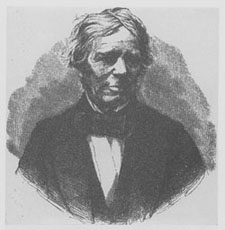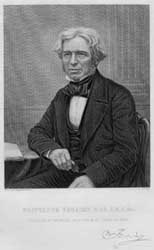Michael Faraday
Natural scientist - discoverer of electro-magnetic induction
1791 - 1867

Studious and largely self educated
The son of a Yorkshire blacksmith, who had moved south, marrying a Surrey farmer's daughter, Michael Faraday was born at Newington Butts on 22 September 1791. The family later moved to Jacob's Wells Mews near Manchester Square, London.
In 1803 he became an errand boy working for a bookbinder and stationer, called Riebau. The next year Riebau took him on as an apprentice, and he lived on the premises for the next eight years, working as a bookbinder.
Faraday was studious and largely self educated. In 1812 he attended lectures given by Sir Humphrey Davy at the Royal Institution.
Assistant to Sir Humphrey Davy
His enthusiasm led to Davy taking him on as an assistant working in his laboratory and participating in chemical experiments. He also became a skilled lecturer.
In 1813 he accompanied Davy and Lady Davy on their continental tour, visiting some of the leading European scientists. The visit lasted until 1815. Although Davy treated Faraday as an equal, Lady Davy regarded him as a mere servant.
The discovery of electro-magnetic induction
On his return, Faraday was again engaged by the Royal Institution and began the publication of numerous scientific articles increasingly in the field of experimental physics and leading eventually to major discoveries.
His major contribution to natural knowledge was his discovery of electro-magnetic induction. It was this discovery, more than any other, that allowed electricity to be turned from a scientific curiosity into a powerful technology.

Fullerian Professor of Chemistry for lifeFaraday continued with lectures, scientific experiments and publications. In 1831 he was appointed Fullerian professor of chemistry at the Royal Institution, for life. In 1836 he became Scientific Adviser to Trinity House. In the same year he was awarded a state pension of £300 by Lord Melbourne, the Prime Minster.
Personal and religious life
In June 1821, he married his longtime sweetheart Sarah Barnard, she being 21 and Faraday 30. She was an invalid and spent much of her time in a Bath chairFaraday was a deeply religious man and, like his parents, a member of a breakaway Presbyterian sect, known as the Sandemanians*. However, he kept his science and his religion separate, holding that God was not knowable through science.
In 1841 he suffered a nervous breakdown and did not return to his studies until 1844. Around this time he also suffered a physical disability affecting the use of his legs and Thomas Twining III of Twickenham made an invalid chair for him. In 1895 this chair came into the hands of John Rudd Leeson, Twining's doctor and Charter Mayor of Twickenham in 1926. Leeson gave the chair to the Athenaeum in 1908.
A Grace and Favour house in Hampton Court
In 1848, as a result of private representations by the Prince Consort, Michael Faraday was awarded a Grace and Favour house in Hampton Court, free of all expenses for upkeep. This house, the Master Mason's House, later called Faraday House, and now No.37 Hampton Court Road was occupied by Faraday for the next 19 years until his death on 25 August 1867. The house had earlier been an official residence of Sir William Chambers as Comptroller of the Works.When he died Faraday was buried in Highgate cemetery. The house at Hampton Court was then renamed Faraday House, a tribute to his distinction.
*An English form of the Scottish sect of Glassites, followers of John Glas (1695-1773) who was deposed from the Presbyterian ministry in 1728, for teaching that the Church should not be subject to any league or covenant, but should be governed only by Apostolic doctrine. Glas's son-in-law, Robert Sandeman (1718-1771), having been for many years an elder in the Glassite sect, removed to London in 1760, where he gathered a congregation at Glovers' Hall, Barbican. Though for the most part he followed the teaching of Glas, he went beyond that doctrine in maintaining that faith is only a simple assent to Divine testimony which differs in no way from belief in ordinary human evidence. In 1764 Sandeman went to America to propagate his views, and founded some congregations there, for which reason the Glassites in America, like those in England, are known as Sandemanians. In England the sect has never been numerous, possessing less than a dozen meeting-places in the whole country, including two in London. It is chiefly known owing to Faraday having officiated as a Sandemanian elder in London.
Further reading
London Borough of Richmond upon Thames, Local Studies Library (”Faraday” and “Faraday House”) including photographs of B L Pearce, Thomas Twining of Twickenham, Borough of Twickenham Local History Society Paper No 61, 1988Charles Spicer, article on “Faraday House”
Gerald Heath (ed Kathy White & Joan Heath), Hampton Court - the story of a village, The Hampton Court Association, 2002
Dictionary of National Biography




